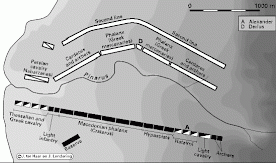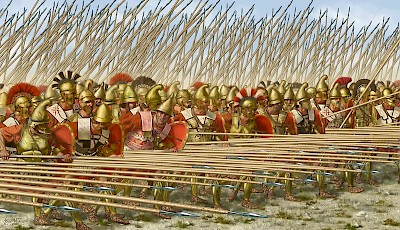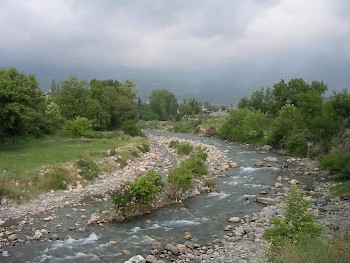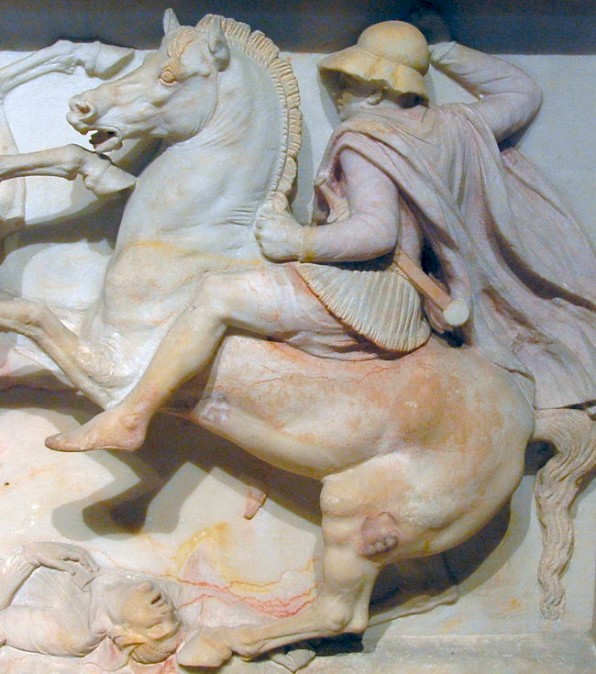Issus (2)
Battle of Issus (5 or 6 November 333 BCE): famous battle during the war between Macedonia and the Persian Empire. The Macedonian king Alexander the Great defeated Darius III Codomannus, won Phoenicia and Egypt, and destroyed the Persian army.
Attack

It must have been about 15:30 when the Macedonian army was ready to proceed into the zone, about 250 meter deep, that was covered by the Persian archers. Seated on his horse Bucephalus, Alexander rode in front of his troops, shouted some words of encouragement, and ordered the attack. The soldiers must have said their prayers, and started to move forward towards the Pinarus and the archers.
When they heard the clamor produced by the simultaneous release of thousands of bow strings, the Macedonians prepared themselves for the incoming arrows, bowing down a bit to protect their faces. The sound of the projectiles, raining down on the metal panoplies, was terrible. Those who were hit were shouting, and horses panicked. Even to the most experienced soldiers, the impact was demoralizing, but they knew how to inspire themselves and their comrades again:
The Macedonians first raised an unearthly shout followed by the Persians answering, so that the whole hillside bordering the battlefield echoed back the sound, and this second roar in volume surpassed the Macedonian war cry. note

A trained archer needs about five seconds to put his arrow on the string, aim, and release the missile. Opponents who approached him on feet, would be in his field of fire for about a minute and a half - from the moment of the first volley until the moment when the archer had to start looking for cover. This means that any archer would shoot about twenty arrows. It is a common misunderstanding that they were released volley after volley, but this is impossible. During a battle, it is too noisy to coordinate these actions, and besides: enemies can prepare for volleys, but not for continuous fire.
If there were two thousand archers on each of the Persian wings (an extremely low estimate), the heavy infantry of the Macedonian army could expect about 40,000 arrows, which were increasingly on target as the phalanx approached its enemy. Several hoplites fell and there were gaps in the Macedonian battle array. When the two armies were less than a hundred meter from each other, the archers abandoned their position, and walked through their own lines, to the relative safety behind the front.
Infantry fight

Now, the fight was about to begin. The cavalry had already clashed on the wings when the first battalions of the Macedonian phalanx reached the Pinarus. The little river was not very deep, but it was full of sharp stones, and the sandy banks were slippery: after all, it had been raining for several days. The soil became even more slippery when more soldiers crossed to the northern bank. Several men fell, others had to move to the left or right to prevent irregularities in the river; the phalanx lost cohesion, especially because the Pinarus meanders and not all battalions reached the river at the same time. When the soldiers reached the northern bank, the gaps in the phalanx must have been considerable. Arrian tells what happened:
Darius' Greek mercenaries attacked precisely at the point in the line where the gap was widest. There was a violent struggle. Darius' Greeks fought to thrust the Macedonians back into the water [...], while the Macedonians, in their turn [...], were determined not to forfeit the proud title of invincible, hitherto universally bestowed upon them. The fight was further embittered by the old racial rivalry of Greek and Macedonian. It was in this phase of the battle that Ptolemy, son of Seleucus, and about 121 Macedonians of distinction met a soldier's death. note
The Greek phalanx in the Persian army was probably deeper and more massive, but the Macedonian soldiers had longer lances. During the often crucial first seconds, the Macedonian was in a better position. He must have aimed at his opponent's vulnerable places. An experienced warrior might aim at his enemy's face and kill him with one thrust, but against the Greek professionals, this was hardly possible; the lance would be caught on the shield. The Greek would try to push the Macedonian lance to the ground, where it was useless, while his enemy attempted to pierce through the shield and hit hs opponent's chest. A fraction of a second later, the Greek mercenary could be struck by a lance from the second line of the Macedonian army. He could be wounded in one of his lungs, fall down, and would die from loss of blood and dyspnoea, being treampled underfoot by those who were fighting over him.
The Macedonian advantage lasted for only a couple of seconds. The Greek phalanx, armed with three meter spears that were, when the two arrays collided, used in the same way as the six meter Macedonian lance, now had the advantage of its superior numbers. Besides, Persian light armed soldiers threw missiles from behind the Greek mercenaries into the Macedonian phalanx, which created serious damage and helped to open the already existing gaps even more.
In this way, the two armies were locked to each other, with their lances and spears pierced into their enemies' lines. The clash of the phalanxes resembled, if it is permissible to compare a battle to a game, a scrum during a rugby match. That side which was able to exercise most pressure, would eventually overthrow its enemy. The Greeks were more numerous and stronger, and the Macedonians were gradually pushed back to the river. Giving all they had, the soldiers pushed against each other, gasping, sweating, stumbling across the fallen, with ringing ears, their feet slipping in the mud, and a furiously beating heart. Curtius Rufus describes the difficult position of the Macedonian soldiers:
Then the blood really flowed, for the two lines were so closely interlocked that they were striking each other's weapons with their own and driving their blades into their opponents' faces. It was now impossible for the timid or cowardly to remain inactive. Foot against foot, they were virtually engaging in single combat, standing in the same spot until they could make further room for themselves by winning the fight: only by bringing down his opponent could each man advance. But, exhausted as they were, they were continually being met by a fresh adversary, and the wounded could not retire form the battle as on other occasions because the enemy were bearing down on them in front while their own men were pushing them from behind. note
Foot against foot: the lines were so densely packed that the soldiers could try to force their opponents to the ground with a kick to the shins or a knee in the cross. Macedonian soldiers who lost their balance fell into the sucking mud and were trampled underfoot by the Greek mercenaries, who were slowly moving forward. Those who were still alive when the phalanx had moved over them, were killed by the light armed soldiers that stood behind the lines and had been throwing spears.
Sword wounds were often large, and usually, an artery was hit. Those who were wounded like this, were lucky, because the shock, the loss of blood, and the fast beating of the heart ensured that death occurred within a minute. The ancient stock phrase that the river was red with blood is not used in the ancient accounts of the battle of Issus, but may have been applicable.
The coherence of the Macedonian battle array had already been lost when the soldiers had marched across the river. The rain of spears from the light armed behind the Greek phalanx had made the gaps even wider. Darius' mercenaries proceeded into these gaps and used their swords to attack the flanks of the Macedonian soldiers. It was obvious to all that the Greek infantry was close to victory.
Cavalry fight on the beach
On the Persian right wing, victory had already been achieved. Alexander's cavalry, which consisted of horsemen from the Greek allies and the Thessalian riders, had crossed the shallow delta of the Pinarus, but had had been blocked by the Persian horsemen, which were superior in numbers and were commanded by Darius' chiliarch, Nabarzanes.
They had now come within javelin-range when the Persian cavalry made a furious charge on the left wing of their enemy; for Darius wanted the issue decided in a cavalry engagement since he presumed that the phalanx was the main strength of the Macedonian army. note
Within a few minutes, one of the Thessalian squadrons had been annihilated. The Persians started to push back the other Thessalian riders and the Greek allies, into and across the river. Parmenion ordered them to regroup, but the enemies came across the river in great numbers, and were already winging to the left to attack the Macedonian phalanx in the rear. The regrouped Thessalians and Greek allies had to prevent the destruction of the infantry, and could count on the support of the small reserve that Alexander had, with this purpose in mind, placed behind his lines. However, it was a matter of time until the Persian cavalry would surround the reserve and reach the phalanx, which was already forced back by the Greek hoplites.
Macedonian breakthrough
The situation was difficult for the Macedonians, but on their right wing, they had been more successful. The Persian archers who had, at the beginning of the fight, fired at the right wing of the Macedonian phalanx, had returned through the lines of the kardakes. This was a routine maneuver, which must have been repeated ad nauseam when the army was trained. The kardakes may have opened their lines about one minute before the lines collided, let their archers through, and may have closed them again after about thirty seconds. It was during the half minute during which the lines were open, that the Macedonian elite cavalry, the Companions, charged. Arrian offers an account:
Alexander, at the head of his own troops on the right wing, rode at a gallop into the stream. Rapidity was now all in all: a swift attack would shake the enemy, and the sooner they came to grips the less damage would be done by the Persian archers. Alexander's judgment was not at fault: the Persian left collapsed the very moment he was on them.note

With a speed of twenty-five kilometer an hour, the Macedonian cavalry collided with the confused lines of Persian kardakes and archers. The shock of charges like these is not physical, but moral: for an infantry man, the horseman is high, heavy, and swift. He has to be very well-trained to resist his instinct to step back. The line of the kardakes collapsed and the Macedonians used their swords to strike widely. Metal clashed on metal, horses snorted, and while the blood splashed around, the wounded were crying. Those who fell in this pandemonium, were trampled down by the horses, and were lucky if they survived with a collapsed lung or a bruised rib.
It was the type of action that fitted Alexander's theatrical style of leadership. Before he had ordered the attack, he must have known that his own cavalry on the left wing would be defeated, and that his phalanx would find itself in serious trouble. Everything depended on one single cavalry charge, and the success of this charge depended on one factor: the courage of the commander. Seated on Bucephalus and covered in shiny bronze, he was easily recognizable for everyone present, friend and foe. After all, he could only order his men to face the dangers if he visibly shared the risks.
Swiftly, the right wing of the Macedonian phalanx joined Alexander and the Companions in the fight on the north bank of the Pinarus. From the point where Alexander was riding, about fifty meter above the beach, he could see the rest of the battle array, and he understood that he had to do something to prevent the collapse of his phalanx.